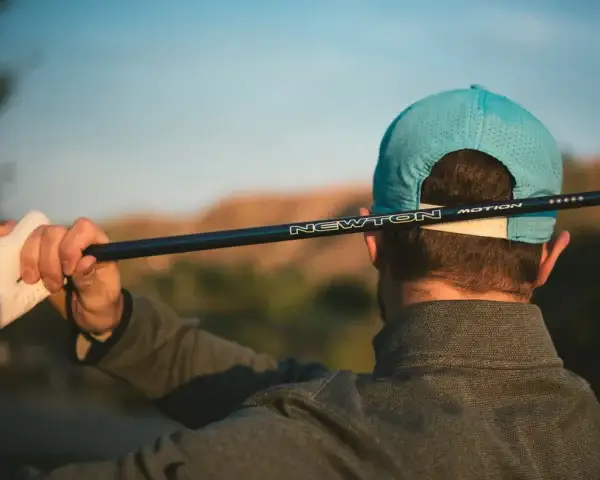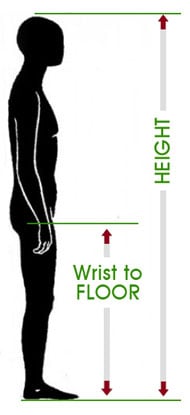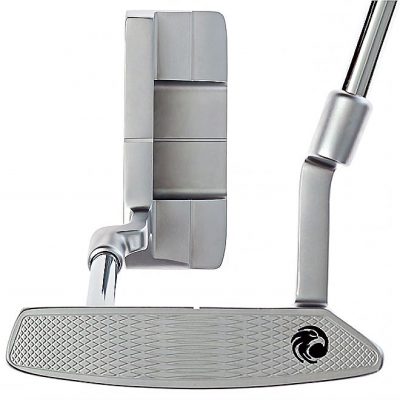
New Newton Motion Golf Shafts Here
Newton Motion Golf Shafts The Newton Motion Golf shafts are designed to help golfers drive it straighter and farther without the need to exert
We hope this golf club fitting page will help you in your quest for the optimal set of clubs! Your best bet is to get fit in person by a professional. If you can’t get fit in person, take some time to read the basic fitting information below to help you choose a set of clubs. We’ve been doing this for many years, and this is the culmination of our successful experience.
To determine what length of irons you need, you can use a simple method called “Wrist To Floor” measurement. Take a yardstick, and while standing straight with your golf shoes on, have someone measure from the floor to the crease of your relaxed wrist.

Most golfers are in the “standard length” range, which will be a measurement of 34 to 36” from floor to wrist. Here is a general chart to help choose an iron set length:
| Wrist-to-floor | 7 iron Length |
| 27″ to 32″ | 36 inches |
| 32″ to 34″ | 36.5 inches |
| 34″ to 36″ | 37 inches |
| 36″ to 38″ | 37.5 inches |
| 38″ to 40″ | 38 inches |
The length you would choose for your Driver and Fairway woods may be a different story. While you can follow the same general fitting rules as irons for length, it is not as critical. For example, someone who is 5’ 4” with a Wrist to Floor of 30”, might still prefer a standard length driver, instead of minus one inch (according to the above chart). The reason for that is, the longer a driver length is, the more distance is possible, and the lie angle (see below) is not as critical on a wood as it is an iron. Modern standard lengths are longer than in the “old days”, since distance is often a priority for the modern golfer. The downside to a longer driver is that it is harder to control for some golfers. You’ll want to play the longest driver that you can control well. For some that is 44”, for others it can be as long as 46”. Many (like this writer) prefer a longer driver, but choose standard length in every other club. All of this is up to you and what’s best for your game. If you are unsure, just choose standard length.
Shaft flex is a very important consideration when choosing new clubs. If you get the flex of your clubs correct, you will maximize your distance and accuracy. It’s true, you may be able to adjust when you are playing an incorrect flex – but it’s best to get your flex dialed in if possible. There are no hard and fast rules as to what an incorrect flex can do to your distance and accuracy, but a common result of too flexible a shaft would be a hook, and a common result of too stiff a flex would be a slice. Too stiff of a shaft can also cause a loss of distance. Again, these results are by no means universal, but these are common results we see.
There are 2 main ways:
1) Get your swingspeed measured by a professional clubfitter with a launch monitor. One word of caution: Sometimes if you get your swingspeed measured on a launch monitor at a “big box” store, the results could be skewed. In an attempt to feed your ego, a launch monitor can be tweaked to yield a higher swingspeed than you are really producing. This may sell clubs, but it does you no favors. Shaft flex determination is a case where you should check your ego at the door in order to produce the best fitting results. If you do get a swingspeed number you trust, below is a very basic guideline as far as flex:
If your swingspeed is less than 70 MPH with a driver, you should use a Ladies Flex.
If your swingspeed is 70-80 MPH with a driver, you should use a Senior (or A) Flex.
If your swingspeed is 81-95 MPH with a driver, you should use a Regular Flex.
If your swingspeed is 95-105 MPH with a driver, you should use a Stiff Flex.
If your swingspeed is 105+ MPH with a driver, you should use an Extra Stiff Flex.
2) Determine which club you would use from 150 yards. If you don’t know your swingspeed and don’t want to get it checked, this can be an alternate method of determining your correct flex. Below is a basic guideline:
If you use a 3 iron or a 3 or 5 wood from 150 yards, you should use a Ladies Flex.
If you use a 4 or 5 iron from 150 yards, you should use a Senior (or A) Flex.
If you use a 6 or 7 iron from 150 yards, you should use a Regular Flex.
If you use a 8 or 9 iron from 150 yards, you should use a Stiff Flex.
If you use a PW from 150 yards, you should be on the PGA Tour – what a stud!
Are there any other factors in determining my correct flex?
Yes. One other factor in determining your correct flex would be your swing “tempo”. What is swing tempo? To put it simply, it is the intensity of the transition from your backswing to your downswing. An example of a smooth tempo, or transition, would be Ernie Els. You can see a video of his tempo here. An example of an aggressive tempo would be Nick Price; you can see that here. If you find yourself to have a smooth tempo, you may want to err on the side of a softer flex. If you believe you have an aggressive tempo, you may want to err on the side of a stiffer flex. If you are in between, then tempo may not be a factor as far as affecting a flex choice.
The Grip:
Choosing a grip comes down to 2 main considerations. Grip Size and Grip Material:
Grip Size:
One way to determine a grip size that’s right for you, would be to go off of your golf glove size. Here is a basic chart to guide you:
Glove Size
Mens X-Large Glove – Midsize to Jumbo Grips
Mens Large Glove – Standard to Midsize Grips
Mens Med-Large Glove – Standard Grips
Mens Small to Medium Glove – Standard Grips
Another consideration may be just personal preference. Many choose grip size based on what feels right to them. They may (according to a chart or conventional wisdom) be supposed to be using a standard size grip, but prefer the feel of a midsize or jumbo grip. A midsize or jumbo grip may also feel better to someone with arthritis or joint pain because they feel they don’t have to grip the club as tightly.
Grip Material:
Grip material generally has no effect on performance, it’s just a matter of personal preference. The following are general categories of grip material:
“Velvet” Style – This is the most popular style of grip. If you are in a golf store and pick up a club, it will generally have this style of grip. The word velvet simply refers to the non-slip surface pattern in the grip. This is a style that works well in any atmospheric conditions, even rain.
Wrap Style – This style is also popular. It is the tackiest feeling grip. This grip style has the barber pole look of the old leather grips.
Dual Materials – Many grips produced now try to combine the best of both worlds when it comes to grip technology. The material under one hand is different from the material under the other hand (for example corded material and softer rubber material).
Corded – These grips have “cords” or “threads” running through the material. Although these are firmer feeling grips, they are the best for traction. If you prefer to not wear a glove, these are a good option.

Newton Motion Golf Shafts The Newton Motion Golf shafts are designed to help golfers drive it straighter and farther without the need to exert

Let Krank Golf Bring More Fun Back in your Game Let us show you how you can have more golf fun with Krank golf. The

WHAT IS THE REASON A GOLFER MIGHT CONSIDER MAKING A CHANGE FROM NORMAL INCREMENTAL LENGTH IRONS TO A SINGLE LENGTH SET OF IRONS?

The Pinhawk On Lock putter is perfectly designed for this USGA approved method of putting.


905-567-4422 / 416-726-4285 (M) Mail@ Info@Konagolfsales.Com
The Dover Coast, Port Dover, Ontario, N0A 1N3
Copyright © 2024 Kona Golf Sales – (a division of 971691 Ontario Limited). All rights reserved.
Our Store / Shipping will be closed thru to Mid April .
Thank you for your Patronage.
If you wish to place an order to reserve an in-stock item, please Contact Us Here and we will follow up.
Sorry for any Inconvenience!